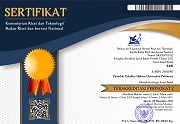Transplantasi Organ Tubuh sebagai Pengganti Hukuman Qhisas dalam Hukum Islam (Studi Terhadap Delik Pelukaan Mata)
 )
)
(1) Fakultas Ekonomi dan Bisnis Universitas Pattimura, Ambon, Indonesia, Indonesia
 Corresponding Author
Corresponding Author
Abstract
Keywords
DOI
10.47268/sasi.v25i2.218
Published
2019-12-27
How To Cite
@article{SASI218,
author = {Amin Ramly},
title = {Transplantasi Organ Tubuh sebagai Pengganti Hukuman Qhisas dalam Hukum Islam (Studi Terhadap Delik Pelukaan Mata)},
journal = {SASI},
volume = {25},
number = {2},
year = {2019},
keywords = {Organ transplants; Punishment Qhishas},
abstract = {This paper deals with the study of Islamic criminal law, which regulates the study of transplants as a substitute for Qhishas punishment, the main issue is to see how the qhisas process of ophthalmic offenses, eye transplantation techniques, and fiqh analysis of eye transplants as a substitute for qhisas punishment. To be able to analyze the problems above, this study uses a type of qualitative research with a normative approach based on the rules of Islamic law (Al-Quran, hadith, and ijtihad), and analyzed by the inductive method according to the Shari'a perspective on the concept of transplantation as qhisas punishment. The results showed that the qhisas for the eye opening offense based on the argument of Al-Maidah verse 45, where the eye must be punished with the eyes, both in terms of the method of wounding practiced must be balanced between the victim and the offender, while the diyat above the eye opening offense is 100 dinars. The eye organ transplant can be done medically by removing the cornea of the eye rather than the eyeball, because the eyeball cannot be transplanted, and the transplant is carried out from the donor to the recipient on all medical requirements by medical means. The analysis of jurisprudence to the concept of eye transplantation as a substitute for the qhishas penalty in sharia is not allowed, because it does not meet the principle of qhishas justice, namely the balance between uqubah with deeds, where the offender is charged with qhishas punishment (medical eye opening) and also charged with diyat punishment (ie costs transplant operations that will be borne by the perpetrator) whose amount can be more than diyat value.},
issn = {2614-2961}, pages = {146--154} doi = {10.47268/sasi.v25i2.218},
url = {https://fhukum.unpatti.ac.id/jurnal/sasi/article/view/218}
}
Buku
[1] Al-Nawawi, Yahya. (1992). Minhaj al-Talibin, Lebanon: dar al-Fikr.
[2] Al-Jazairi, Abu Bakar Jabir. (1995). Minhaj Al-Muslim (cet. Ke-1). Beirut: Dar al Fikr,.
[3] Abdurrahman. Hukum Pidana Menurut Syari’at Islam. Jakarta: Rineka Cipta, 1992.
[4] Al Audah, Abd. Al. Qadir At Tasyari Al Jinayah Al Islamiy. Beirut: Dar Al Kitab Al Arabim Beirut.
[5] As-Syatibi, Abu Ishaq Al-Muqafaqat Fi Ushul A;-Syariah, Juz II, Kairo: Mustafa Muhammad.
[6] Djazuli, A. (1996), Fiqh Jinayah, Bandung: Raja Grafindo Persada.
[7] Faquha, Ahkamul. (2007). Solusi Problematika Aktual Hukum Islam, Keputusan Muktamar, Munas, Dan Konbes Nahdlatul Ulama, (1926-2004 SM). Pen, Djamaluddin Miri Surabaya: Khalista.
[8] Hanafi,A. (1976). Asas-Asas Hukum Pidana Islam (cet. Ke-2). Jakarta: Bulan Bintang.
[9] Jamaa, La. (2013). Transplantasi Organ Tubuh, dalam Fiqh Kontemporer, Ambon, FSEI Press.
[10] Kusuma, Mahmud. (2009). Menyelami Semangat Hukum Progresif, Terapi Paradigmatic Bagi Lemahnya Penegakan Hukum Indonesia. Jogjakarta: Antony Lib-indonesia.
[11] Muchlis, Ahmad Wardi. (2004). Hukum Pidana Islam. Jakarta: Sinar Grafika.
[12] Scacht, Yoseph. (1964). An Introduction to Islamic Law. Oxford: Oxford Universty Press.
[13] Soekanto. Sosiologi Suatu Pengantar. Jakarta: Grafindo.
[14] Umar, Hasbi. (2007). Nalar Fiqih Kontemporer. Jakarta: Gaung Persada Press.
[15] Zaidan, Abdul Karim. (2008). Al-Wajiz, 100 Kaidah Fiqh Dalam Kehidupan Sehari-Hari. Jakarta: Pustaka Al-Kautsar.
Jurnal dan Lain-Lain
[16] Al-Bujayrami, Sulayman. (1998). Hashiyah Sharsh Manjhaj al Tjullab, Vol. 1, Lebanon, Dar, Al-Fikr.
[17] Sulaiman bin Abu Daud, Sunan Abu Daud, Vol. 2 (tt: Dar al-Fikr, tt).
[18] Madjid, Syachril Abdul. (2010), Implementasi Undang-Undang Pelayaran Nomor 17 Tahun 2008, Tentang Kelautan Kapal, Dalam Skripsi Fakultas Syariah IAIN Ambon,.
Cited-By:
1. Tracing the Trajectory and Response of Islamic Law to Organ Transplantation According to the Scales of Shari'ah
Agung Ilham Ramadhan, Imron Mustofa
al-Rasῑkh: Jurnal Hukum Islam vol: 14 issue: 2 first page: 254 year: 2025
Type: Journal [View Source]
| Dublin Core | PKP Metadata Items | Metadata for this Document | |
| 1. | Title | Title of document | Transplantasi Organ Tubuh sebagai Pengganti Hukuman Qhisas dalam Hukum Islam (Studi Terhadap Delik Pelukaan Mata) |
| 2. | Creator | Author's name, affiliation, country | Amin Ramly; Fakultas Ekonomi dan Bisnis Universitas Pattimura, Ambon, Indonesia; Indonesia |
| 3. | Subject | Discipline(s) | |
| 3. | Subject | Keyword(s) | Organ transplants; Punishment Qhishas |
| 4. | Description | Abstract | This paper deals with the study of Islamic criminal law, which regulates the study of transplants as a substitute for Qhishas punishment, the main issue is to see how the qhisas process of ophthalmic offenses, eye transplantation techniques, and fiqh analysis of eye transplants as a substitute for qhisas punishment. To be able to analyze the problems above, this study uses a type of qualitative research with a normative approach based on the rules of Islamic law (Al-Quran, hadith, and ijtihad), and analyzed by the inductive method according to the Shari'a perspective on the concept of transplantation as qhisas punishment. The results showed that the qhisas for the eye opening offense based on the argument of Al-Maidah verse 45, where the eye must be punished with the eyes, both in terms of the method of wounding practiced must be balanced between the victim and the offender, while the diyat above the eye opening offense is 100 dinars. The eye organ transplant can be done medically by removing the cornea of the eye rather than the eyeball, because the eyeball cannot be transplanted, and the transplant is carried out from the donor to the recipient on all medical requirements by medical means. The analysis of jurisprudence to the concept of eye transplantation as a substitute for the qhishas penalty in sharia is not allowed, because it does not meet the principle of qhishas justice, namely the balance between uqubah with deeds, where the offender is charged with qhishas punishment (medical eye opening) and also charged with diyat punishment (ie costs transplant operations that will be borne by the perpetrator) whose amount can be more than diyat value. |
| 5. | Publisher | Organizing agency, location | Faculty of Law, Universitas Pattimura |
| 6. | Contributor | Sponsor(s) | |
| 7. | Date | (YYYY-MM-DD) | 2019-12-27 |
| 8. | Type | Status & genre | Peer-reviewed Article |
| 8. | Type | Type | |
| 9. | Format | File format | PDF (Bahasa Indonesia) |
| 10. | Identifier | Uniform Resource Identifier | https://fhukum.unpatti.ac.id/jurnal/sasi/article/view/218 |
| 10. | Identifier | Digital Object Identifier | 10.47268/sasi.v25i2.218 |
| 11. | Source | Title; vol., no. (year) | SASI; Vol 25, No 2 (2019): Volume 25 Nomor 2, Juli - Desember 2019 |
| 12. | Language | English=en | id |
| 13. | Relation | Supp. Files | |
| 14. | Coverage | Geo-spatial location, chronological period, research sample (gender, age, etc.) | |
| 15. | Rights | Copyright and permissions | Copyright: Authors who publish their manuscripts in this Journal agree to the following conditions: 1. The copyright in each article belongs to the author, as well as the right to patent. 2. Authors can enter into separate, additional contractual arrangements for the non-exclusive distribution of the journal's published version of the work (e.g., post it to an institutional repository or publish it in a book), with an acknowledgment of its initial publication in this journal. 3. Authors are permitted and encouraged to post their work online (e.g., in institutional repositories or on their website) before and during the submission process, as it can lead to productive exchanges, as well as earlier and greater citation of published work. 4. Authors have the right to self-archiving of the article (Author Self-Archiving Policy)
License: The SASI Journal is disseminated based on the Creative Commons Attribution-NonCommercial 4.0 International license terms. This license allows anyone to copy and redistribute this material in any form or format, compose, modify, and make derivatives of this material for any purpose. You cannot use this material for commercial purposes. You must specify an appropriate name, include a link to the license, and certify that any changes have been made. You can do this in a way that is appropriate but does not imply that the licensor supports you or your use.
|
Copyright (c) 2019 Amin Ramly

This work is licensed under a Creative Commons Attribution-NonCommercial 4.0 International License.
Cited-By:
1. Tracing the Trajectory and Response of Islamic Law to Organ Transplantation According to the Scales of Shari'ah
Agung Ilham Ramadhan, Imron Mustofa
al-Rasῑkh: Jurnal Hukum Islam vol: 14 issue: 2 first page: 254 year: 2025
Type: Journal [View Source]

 : 4758 times
: 4758 times Download : 2791 times
Download : 2791 times
















